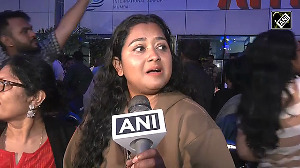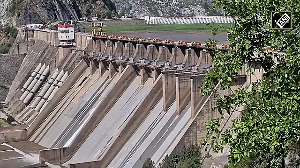Glancing through some Food and Agricultural Organisation papers the other day, I got the shock of my life.
Data available for the last eight years or so showed that rice from Thailand and Vietnam were, for most of the period, cheaper than those produced in India.
And that's when, in several cases, you're comparing better quality rice (with just 5 per cent of the total pieces broken) in Vietnam with inferior ones from India (25 per cent broken).
| |||||||||||
Sadly, they said, Indian rice and wheat doesn't really compare with that from other countries -- indeed, according to one friend who exports wheat, most Indian wheat (thanks to the DDT and other pesticides) is considered unfit for human consumption in several countries, so in countries like Malaysia and Korea, it is bought as animal feed.
In the Middle East, where India manages to sell a fair amount of wheat, it is primarily because the government sells exporters the wheat at Rs 3 to 4 per kg less than the prevailing market price!
That's right, thanks to a policy of mindlessly hiking minimum support prices for wheat and rice to a level where they are well above international prices, most farmers sell only to the Food Corporation of India (even rice sold to traders at lower prices eventually finds its way to the FCI godowns to avail of the higher prices) -- so the only way exports can take place is if the government sells them at a discount to exporters!
Apart from being something other countries could take India to the World Trade Organisation for, what it really means is that India's domestic policies have made it uncompetitive.
In fact, according to agriculture economist, Ramesh Chand at the Institute of Economic Growth, who has calculated various criteria such as the Nominal Protection Coefficient, Effective Protection Coefficient, and so on, Indian wheat is just not competitive except when international prices are very high, especially when you take into account high transport costs from growing areas in Punjab to, say, the Mumbai port -- the costs from Punjab to just the Mumbai port could be as high as between half to a third of the cost from India to the US!
The position in rice is better, but not enough to make India a large exporter on a sustained basis.
In fact, one of my exporter friends added, Indian rice quality is usually so poor that it sells at a discount of around $25-30 a tonne in comparison to Thai rice.
And while our basmati is of world quality, it costs 15-20 per cent more than the Pakistani varieties.
The good news here is that India is able to make up for this by convincing buyers that Indian basmati is the real thing!
One of our top rice exporters, United Riceland, regularly puts out genetic markers to distinguish genuine basmati (naturally, the varieties from India), and, so far, buyers believe Indian basmati is the best.
While that is certainly good news, the question to be asked, on the eve of the Cancun ministerial meeting, is why is India so keen on fighting for cuts in the huge European /American farm subsidies since it is almost certain the Thais, the Vietnamese, and other efficient members of the Cairns Group of agriculture-exporting countries will take away the lion's share of the spoils when world farm trade genuinely opens up?
In fact, in another sector that is about to fully open up in 2005, textiles, India is facing much the same problem.
Today, as is well known, global trade in textiles and garments is largely regulated by quotas -- that is, countries like the US and the EU have quotas to regulate imports of various items.
So, the EU may have a quota for 100,000 ladies blouses, equally divided between India and China.
Now, even if China's blouses are a third cheaper than India's, the Europeans cannot buy all the blouses from China, they'll have to buy half of them from India.
So, the quotas originally designed to protect western markets from cheap imports are actually helping countries like India maintain market share. All this, however, will change in 2005 when the quota regime gets over.
What happens then? Theoretically, India's exports should boom, but we have the same problem of the agriculture sector over here as well -- namely, that distorted domestic policies have crippled the sector so much, its capacity to compete is severely limited right now.
Fellow BS columnist, and consultant Arvind Singhal, for instance, cites the instance of Wal-Mart's first order for Levi's Signature line of jeans -- it's a 46 million pair order! That's around 60 million meters of fabric that has to be consistent in quality, with no shade variations.
Less than a handful of Indian mills have such capacity since, thanks to a policy that gave huge tax benefits to small powerloom units (this budget reversed this policy), India's large weaving sector has all but disappeared -- under five per cent of total cloth produced in the country is woven in big mills.
If the mills can't produce such large amounts of cloth with the same consistency and uniformity, it's obvious the readymade garments sector cannot possibly service large orders of the Wal-Mart kind either.
And we're not even talking of the problems the readymade garment units have in the form of rigid labour laws that do not allow them to set up large stitching facilities -- if Wal-Mart has to deal with one or two Chinese garmenters as compared to 100 Indian ones, it's pretty easy to figure out who it will choose.
So, if India's domestic policies hinder her ability to compete globally, what are we doing at the WTO? My rice exporter friend, of course, has a different take on this. According to him, it is only people who cannot export who need the WTO!





 © 2025
© 2025